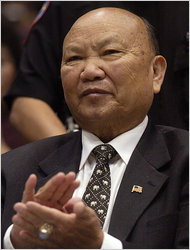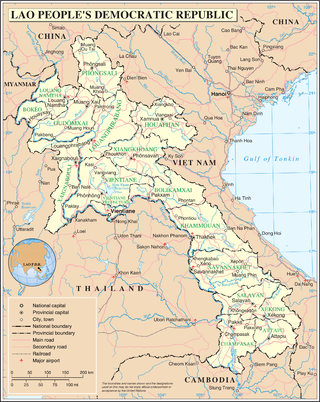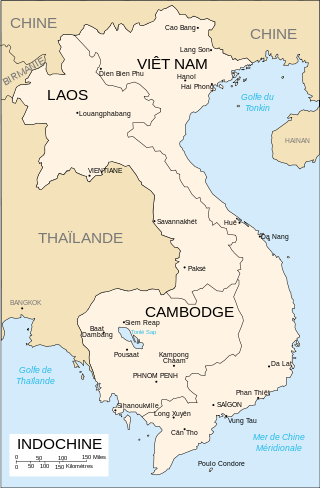Some Hmong groups fought as CIA-backed units on the Royalist side in the Laos civil war. After the Pathet Lao took over the country in 1975, the conflict continued in isolated pockets. In 1977 a communist newspaper promised the party would hunt down the "American collaborators" and their families "to the last root". [3]
Hmong refugees and repatriation
As many as 200,000 Hmong went into exile in Thailand, with many ending up in the USA. A number of Hmong fighters hid out in mountains in Xiangkhouang Province for many years, with a remnant emerging from the jungle in 2003. [3]
In 1989, the United Nations High Commissioner for Refugees (UNHCR), with the support of the United States government, instituted the Comprehensive Plan of Action, a program to stem the tide of Indochinese refugees from Laos, Vietnam, and Cambodia. Under the plan, the status of the refugees was to be evaluated through a screening process. Recognized asylum seekers were to be given resettlement opportunities, while the remaining refugees were to be repatriated under guarantee of safety.
After talks with the UNHCR and the Thai government, Laos agreed to repatriate the 60,000 Lao refugees living in Thailand, including several thousand Hmong people. Very few of the Lao refugees, however, were willing to return voluntarily. [7] Pressure to resettle the refugees grew as the Thai government worked to close its remaining refugee camps. While some Hmong people returned to Laos voluntarily, with development assistance from UNHCR, allegations of forced repatriation surfaced. [8] Of those Hmong who did return to Laos, some quickly escaped back to Thailand, describing discrimination and brutal treatment at the hands of Lao authorities. [9] In 1993, Vue Mai, a former Hmong soldier who had been recruited by the U.S. Embassy in Bangkok to return to Laos as proof of the repatriation program's success, disappeared in Vientiane. According to the U.S. Committee for Refugees, he was arrested by Lao security forces and was never seen again.
Following the Vue Mai incident, debate over the Hmong's planned repatriation to Laos intensified greatly, especially in the U.S., where it drew strong opposition from many Democratic and moderate and American conservatives Republicans as well as some human rights advocates, including Philip Smith of The Centre for Public Policy Analysis and the Lao Veterans of America. In an October 23, 1995 National Review article, Michael Johns, the former Heritage Foundation foreign policy expert and Republican White House aide, labeled the Hmong's repatriation a Clinton administration "betrayal," describing the Hmong as a people "who have spilled their blood in defense of American geopolitical interests." [10] Debate on the issue escalated quickly. In an effort to halt the planned repatriation, the Republican-led U.S. Senate and U.S. House of Representatives both appropriated funds for the remaining Thailand-based Hmong to be immediately resettled in the U.S.; Clinton, however, responded by promising a veto of the legislation.
In their opposition of the repatriation plans, key Democrats as well as Republicans also challenged the Clinton administration's position that the Laotian government was not systematically violating Hmong human rights. U.S. Representative Steve Gunderson (R-WI), for instance, told a Hmong gathering: "I do not enjoy standing up and saying to my government that you are not telling the truth, but if that is necessary to defend truth and justice, I will do that." [10] Republicans also called several Congressional hearings on alleged persecution of the Hmong in Laos in an apparent attempt to generate further support for their opposition to the Hmong's repatriation to Laos.
Although some accusations of forced repatriation were denied, [11] thousands of Hmong people refused to return to Laos. In 1996, as the deadline for the closure of Thai refugee camps approached, and under mounting political pressure, the U.S. agreed to resettle Hmong refugees who passed a new screening process. [12] Around 5,000 Hmong people who were not resettled at the time of the camp closures sought asylum at Wat Tham Krabok, a Buddhist monastery in central Thailand where more than 10,000 Hmong refugees were already living. The Thai government attempted to repatriate these refugees, but the Wat Tham Krabok Hmong refused to leave and the Lao government refused to accept them, claiming they were involved in the illegal drug trade and were of non-Lao origin. [13]
In 2003, following threats of forcible removal by the Thai government, the U.S., in a significant victory for the Hmong, agreed to accept 15,000 of the refugees. [14] Several thousand Hmong people, fearing forced repatriation to Laos if they were not accepted for resettlement in the U.S., fled the camp to live elsewhere within Thailand where a sizable Hmong population has been present since the 19th century. [15]
In 2004 and 2005, thousands of Hmong fled from the jungles of Laos to a temporary refugee camp in the Thai province of Phetchabun. [16] These Hmong refugees, many of whom are descendants of the former-CIA Secret Army and their relatives, claim that they have been attacked by both the Lao and Vietnamese military forces operating inside Laos as recently as June 2006. The refugees claim that attacks against them have continued almost unabated since the war officially ended in 1975, and have become more intense in recent years.
Lending further support to earlier claims that the government of Laos was persecuting the Hmong, filmmaker Rebecca Sommer documented first-hand accounts in her documentary, Hunted Like Animals, [17] and in a comprehensive report which includes summaries of claims made by the refugees and was submitted to the U.N. in May 2006. [18]
The European Union, [19] UNHCHR, and international groups have since spoken out about the forced repatriation. [19] [20] [21] [22] The Thai foreign ministry has said that it will halt deportation of Hmong refugees held in Detention Centers Nong Khai, while talks are underway to resettle them in Australia, Canada, the Netherlands and the United States. [23]
For the time being, countries willing to resettle the refugees are hindered to proceed with immigration and settlement procedures because the Thai administration does not grant them access to the refugees. Plans to resettle additional Hmong refugees in the U.S. have been complicated by provisions of President George W. Bush's Patriot Act and Real ID Act, under which Hmong veterans of the Secret War, who fought on the side of the United States, are classified as terrorists because of their historical involvement in armed conflict. [24]
On December 27, 2009, The New York Times reported that the Thai military was preparing to forcibly return 4,000 Hmong asylum seekers to Laos by the end of the year: [25] the BBC later reported that repatriations had started. [26] Both United States and United Nations officials have protested this action. Outside government representatives have not been allowed to interview this group over the last three years. Médecins Sans Frontières has refused to assist the Hmong refugees because of what they have called "increasingly restrictive measures" taken by the Thai military. [27] The Thai military jammed all cellular phone reception and disallowed any foreign journalists from the Hmong camps. [26]











